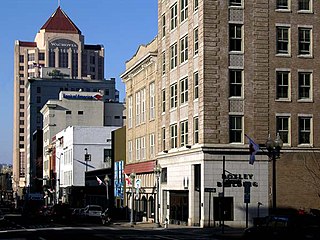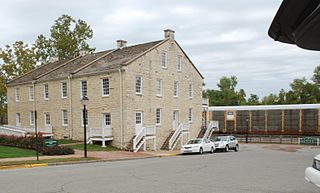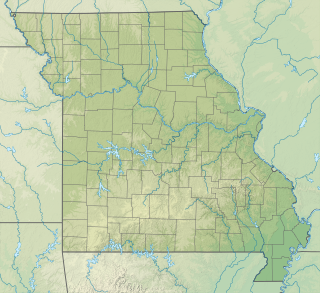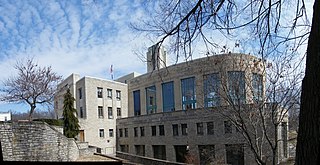
The Library District is an officially designated neighborhood in Downtown Kansas City, Missouri, United States, roughly bounded by 9th and 11th Streets on the north and south and Main Street and Broadway on the east and west. The District contains a sub-district named the West Ninth Street/Baltimore Avenue Historic District listed on the National Register and which includes several buildings individually listed on the National Register of Historic Places. It also contains other notable structures not listed on the National Register.

Downtown Columbia is the central business, government, and social core of Columbia, Missouri and the Columbia Metropolitan Area. Three colleges — the University of Missouri, Stephens College, and Columbia College — all border the area. Downtown Columbia is an area of approximately one square mile surrounded by the University of Missouri on the south, Stephens College to the east, and Columbia College on the north. The area serves as Columbia's financial and business district and is the topic of a large initiative to draw tourism, which includes plans to capitalize on the area's historic architecture and Bohemian characteristics. The downtown skyline is relatively low and is dominated by the 10-story Tiger Hotel, built in 1928, and the 15-story Paquin Tower.

The Roanoke Downtown Historic District is a national historic district located in the Downtown Roanoke area of Roanoke, Virginia. It encompasses 122 contributing buildings. It includes a variety of commercial, institutional, social, and governmental buildings and structures from the late 19th century to the mid-20th century. Notable buildings include the Roanoke City Public Library, the YMCA Central Branch Building, First Christian Church (1925), the Central Church of the Brethren (1924), Tomnes Cawley Funeral Home (1928), Thomas B. Mason Building (1961), Peerless Candy Co., City Hall / Municipal Building (1915), Roanoke Times Building (1892), Anchor Building / Shenandoah Building (1910), Greene Memorial Methodist Church (1890), and United States Post Office and Courthouse (1930). Located in the district are the separately listed Patrick Henry Hotel, the Boxley Building, the Campbell Avenue Complex Historic District, Colonial National Bank, and First National Bank.

Jefferson Landing State Historic Site is a historic district maintained by the Missouri Department of Natural Resources encompassing several state-owned properties in Jefferson City, Missouri, United States. The historic site includes the Christopher Maus House, the Union Hotel, and the Lohman's Landing Building, which was listed on the National Register of Historic Places in 1969.

Roaring River State Park is a public recreation area covering of 4,294 acres (1,738 ha) eight miles (13 km) south of Cassville in Barry County, Missouri. The state park offers trout fishing on the Roaring River, hiking on seven different trails, and the seasonally open Ozark Chinquapin Nature Center.

The Commercial Street Historic District is a national historic district located between Washington Ave. and Grant Ave. in Springfield, Missouri, United States. The district encompasses 57 contributing buildings in Springfield's central business district. The district developed between about 1870 and 1935, and it includes representative examples of Romanesque Revival and Victorian style architecture. Notable buildings include the Thos. Murray Building (1908), Fire Station No. 2 (1904), Perkins Hotel (1902–1908), Bank of Springfield, Bakers' Union Hall (1908), Uncle Carl Haden’s Pawn Shop (1902–1910), and Commercial Club.

This is a list of the National Register of Historic Places listings in Pemiscot County, Missouri.

Edinburgh Commercial Historic District is a national historic district located at Edinburgh, Johnson County, Indiana. The district encompasses 48 contributing buildings in the central business district of Edinburgh. It developed between about 1854 and 1941, and includes notable examples of Italianate, Late Victorian and Classical Revival style architecture. Notable buildings include the Edinburgh Interurban Depot (1919), Mooney House, A. C. Thompson / Danner Building (1854), A. C. Thompson Bank (1872), Masonic Temple (1915), IOOF Building (1888), Central Hotel / Toner House (1855), and Edinburgh Town Hall (1920).

Excelsior Springs Hall of Waters Commercial East Historic District is a national historic district located at Excelsior Springs, Clay County, Missouri. It encompasses 24 contributing buildings and 2 contributing structures in the central business district of Excelsior Springs. The district developed between about 1894 and 1948, and includes representative examples of Victorian architecture. The central feature of the district, the separately listed Hall of Waters, is a five level, Art Deco / Depression Modern style reinforced concrete building. Other notable buildings include the Flanders Dry Goods Store, A.M. Howard Drug Store (1905-1909), Clay County State Bank (1906), The Huey Building (1908), Oriental Bazaar Gift Store (1908), The Excelsior Baths and Broadway Rooms, Fraternal Order of Eagles Lodge Hall, The Kennedy Building (1902), First National Bank Building, The Francis Hotel, and The Auditorium.

Excelsior Springs Hall of Waters Commercial West Historic District is a national historic district located at Excelsior Springs, Clay County, Missouri. It encompasses 20 contributing buildings in the central business district of Excelsior Springs. The district developed between about 1894 and 1948, and includes representative examples of Victorian, Classical Revival, and Art Deco style architecture. Notable buildings include the Excelsior Springs Post Office (1914), McCleary Thornton-Minor Hospital, Montgomery Ward Building (1929), J.J. Newberry Company Building, J.C. Penney Company Building, Elks Lodge No. 1001, Washington Hotel and Orpheus Theatre, I.O.O.F. Building (1913-1917), Arlington Hotel (1899-1900), and Ideal Hotel.

Munichburg Commercial Historic District is a national historic district located at Jefferson City, Cole County, Missouri. It encompasses nine contributing buildings in Jefferson City. The district developed between about 1892 and 1951, and includes representative examples of Early Commercial and One and Two Part Commercial architecture. Notable buildings include the Nieghorn House Hotel (1892), Southside Barber Shop, Schmidt Shoe Store (1908), Southside Dry Goods, Milo H. Walz Hardware Store, Milo H. Walz Furniture Store (1936), Henry Schmidt Grocery Store, Central Dairy, and Busch's Florist.

Blackwater Commercial Historic District is a national historic district located at Blackwater, Cooper County, Missouri. The district encompasses 12 contributing buildings in the central business district of Blackwater. It developed between about 1889 and 1950, and includes representative examples of Late Victorian style architecture. Notable buildings include the Frady Hotel, Adam Schuster Building, Lee O'Neal Hardware Store, and L. F. Berry, John Smith and Lizzie Fisher Building.

West Walnut Street Commercial Historic District is a national historic district located in Springfield, Missouri, United States. The district encompasses 14 contributing buildings in a commercial section of Springfield. The district developed between about 1888 and 1951, and includes representative examples of Italianate commercial architecture. Notable buildings include the Diffenderffer Building (1906), the Koenigsbruk and Boehmer Building, and the Grand Hotel / Springfield Seed Co. Building.

South Avenue Commercial Historic District is a national historic district located in Springfield, Missouri, United States. The district encompasses 10 contributing buildings in a commercial section of Springfield. The district developed between about 1895 and 1949, and it includes representative examples of Italianate and Colonial Revival style architecture. Notable buildings include the Medical Arts Building (1929) and Springfield Life Building/Savoy Hotel/Hotel Seville.

Campbell Avenue Historic District is a national historic district located in Springfield, Missouri, United States. The district encompasses 11 contributing buildings in a commercial section of Springfield. The district developed between about 1885 and 1948, and it includes representative examples of Italianate and Colonial Revival style architecture. Notable buildings include the McLaughlin Block and Busy Bee Department Store.

Middle West Hotel, also known as Grand Opera House and Webb City Opera House, is a historic hotel building located at Webb City, Jasper County, Missouri. It was built in 1883, and housed an opera house. It was remodeled to its present form in 1902, and is a three-story, brick commercial building with brick corner pilasters and limestone trim.

Edina Double Square Historic District is a national historic district located at Edina, Knox County, Missouri. The district encompasses 37 contributing buildings in the central business district of Edina. It developed between about 1865 and 1945 and includes representative examples of Italianate and Streamline Moderne style architecture. Notable contributing buildings include the Public Works Administration funded Knox County Courthouse (1934–1935) designed by William B. Ittner, Bishoff Bakery (1891), Northern Hotel (1860s), Ennis House/Northern Hotel, Edina School and Gymnasium (1915–1916), D. H. Mudd Building, Phillip Linville Building, Tobias J. Lycan Building, Jacob Pugh Building, Albert G. Bostick Building, Knox County Savings Bank, Thomas Burk Buildings, Bank of Edina Building, Joseph F. Biggerstaff Buildings, Stablein Building, and Knox County Public Library.

Chillicothe Commercial Historic District is a national historic district located at Chillicothe, Livingston County, Missouri. The district encompasses 24 contributing buildings in the central business district and surrounding residential area of Chillicothe. It developed between about 1889 and 1950, and includes representative examples of Queen Anne, Italianate, Beaux Arts, Mission Revival, and Art Deco style architecture. Notable buildings include the Scruby Brothers Building (1893), S. A. Stone Building, Dairy Creme Building, Strand Coffee Shop Building (1936), Strand Hotel and Garage (1925), Norman & Jarvis Funeral Home Building, Empire Theatre (1916), Chillicothe Post Office/Federal Building (1916), Grace & Simpson Apartments (1916), and Loomis Building/Chillicothe Post Office (1898).

The Sedalia Commercial Historic District is a national historic district located at Sedalia, Pettis County, Missouri. It encompasses 102 contributing buildings in the central business district of Sedalia. The district developed between about 1870 and 1959, and includes representative examples of Italianate, Romanesque Revival, and Art Deco architecture. Located in the district are the separately listed Hotel Bothwell, Building at 217 West Main Street, and Missouri/Sedalia Trust Company. Other notable buildings include the First United Methodist Church (1888-1891), Pettis County Courthouse (1924), Anheuser Busch Bottling Works, the New Lona Theater (1920), Citizens National Bank Building, Third National Bank (1929), Federal Building (1930), Montgomery Ward Building (1936), the Uptown Theatre (1936), Missouri Pacific Depot, and Central Presbyterian Church.

Hotel Bothwell is a historic hotel building located at Sedalia, Pettis County, Missouri. It was designed by H.L. Stevens & Company and built in 1927. It is a seven-story, Classical Revival style reinforced concrete building faced with tan brick and stone trim. The basement, first, and second floors occupy the full rectangular parcel, whereas the upper stories have an L-shaped plan.





















